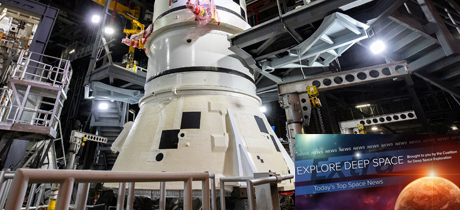In Today’s Deep Space Extra… A new NASA report outlines the science priorities for Artemis III. The latest commercial cargo mission to the International Space Station (ISS) delivers a commercial airlock developed by Nanoracks. Chuck Yeager, the first pilot to break the sound barrier and a central figure in the book “The Right Stuff” passed away Monday at age 97.
Human Space Exploration
Core stages for crewed NASA Artemis missions now under production
Executive.gov (12/3): Technicians are manufacturing Space Launch System (SLS) core stages for the Artemis II and Artemis III lunar missions at NASA’s Michoud Assembly Facility. All the main core stage structures for Artemis II have been built and are being outfitted with electronics, feedlines, and propulsion systems. Engineers are welding the core stage structures for Artemis III, the first mission in the Artemis program to land astronauts on the Moon, through a process called friction stir welding.
What Artemis astronauts could learn about the Moon when they land in 2024
CNN (12/7): NASA on Monday released its “Artemis III Science Definition Team Report: A Bold New Era of Human Discovery,” addressing the science objectives of NASA’s Artemis initiative to return humans to the surface of the Moon. The report includes recommendations on the training Artemis astronauts will need, including intense classroom and field instruction in geology.
The future of Mars exploration, from sample return to human missions
The Space Review (12/7): A mission to return samples from Mars is a major robotic mission planned for the coming decade, but it is not the only one. The Mars Ice Mapper, an orbiter equipped with a synthetic aperture radar designed to search for subsurface ice, is also planned as a precursor to support later human trips to Mars.
Space Science
Capsule with asteroid samples arrives in Japan for researchU.S. News (12/7): Over the weekend, the Japan Aerospace Exploration Agency (JAXA) celebrated the end of a six-year asteroid sample return mission, as the capsule from the Hayabusa 2 spacecraft descended intact into Australia. Following a successful recovery, the container with material gathered from asteroid Ryugu was flown from Australia to Japan. Scientists hope that samples from Ryugu, along with samples of asteroid Bennu collected by NASA’s OSIRIS-REx mission and poised to come back to Earth in 2023, will expand humanity’s knowledge of the solar system and our own planet.
Here are 10 of Arecibo’s coolest achievements
Science News (12/7): In honor of Arecibo’s 57-year tenure as one of the world’s premier observatories, this article lists 10 of the telescope’s coolest accomplishments, presented in roughly reverse order of coolness.
Other News
Chuck Yeager, pilot who broke the sound barrier, dies at 97
CNN (12/7): Military fighter and test pilot Chuck Yeager, whose “right stuff” led to his becoming the first person to break the sound barrier in flight on October 14, 1947, died Monday in a Los Angeles hospital. Yeager was 97.
SpaceX’s 1st upgraded Dragon cargo ship docks itself at Space Station with science, goodies and new airlock
Coalition Members in the News – Nanoracks, Northrop Grumman
Space.com (12/7): Among a SpaceX Dragon cargo delivery to the International Space Station (ISS) was the Nanoracks Bishop Airlock. Bishop is the first commercial airlock added to the ISS and will be attached to the port on U.S. Node 3, also called Tranquility.
Millennium Space experiment to demonstrate technology to rapidly deorbit satellites
Coalition Member in the News – Boeing
SpaceNews.com (12/7): Two Millennium Space Systems small satellites launched last month will conduct an experiment where one has a deployable tether and the other one does not. The experiment aims to demonstrate that the tethered satellite will reenter the earth’s atmosphere and burn up in 45 days while the untethered one could take seven years. Tom Russell, interim CEO of Millennium Space Systems, said the technology could be a solution to orbital debris. Millennium Space Systems is a Boeing subsidiary.

